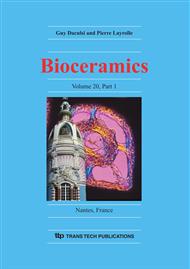p.515
p.519
p.523
p.527
p.531
p.535
p.539
p.543
p.547
Effect of a Silane Coupling Agent on Mechanical Properties of Hydroxyapatite/Polycaprolactone Composites
Abstract:
Silanization of hydroxyapatite was employed to improve the bonding between hydroxyapatite and polycaprolactone. FTIR of HA after silanization showed that new peaks attributed to silane do exist. The increase of melting and crystallization temperatures of silaned composites shown from DSC implied that there exists much stronger bonding between PCL and silaned HA particles. Fracture surface of composites after tensile testing observed by using SEM showed that silaned HA particles dispersed much evenly and coalesced compactly in PCL matrix, suggesting that silaned HA particles had good compatibility with PCL. The tensile strength and modulus increased from 16.81 MPa and 239.21 MPa to 20.49 MPa and 539.57 MPa, respectively.
Info:
Periodical:
Pages:
531-534
Citation:
Online since:
November 2007
Price:
Сopyright:
© 2008 Trans Tech Publications Ltd. All Rights Reserved
Share:
Citation:


